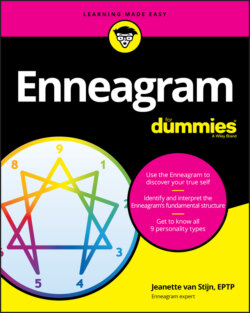Читать книгу Enneagram For Dummies - Jeanette van Stijn - Страница 88
На сайте Литреса книга снята с продажи.
Three centers of knowledge
ОглавлениеNumerous spiritual traditions, in many places in the world and during various epochs of history, refer to three centers of knowledge: knowledge with the head, with the heart, and with the gut. In Plato’s The Republic (Book IV, 6-18), he (427-347 BC) briefly describes a human's physical structure: first, the head, home to their thinking capacity, with logical or intuitive reason; second, the chest, “which concerns courage,” the potential for inspiration, for heroism, perseverance but also rage; and third, the abdomen, the instincts and passions which are at the service of human nourishment and procreation. When they act according to plan, the associated capacities are called wisdom (head), courage (chest), and moderation (body). These are the three essential human virtues that belong to the head, heart, and gut. There are plenty of deviations from these virtues — vices, in other words. That's because, whereas on one hand, virtue signifies accordance with the developmental laws of humans and this accordance is only possible in one form, on the other hand you have innumerable ways to diverge from this one possible form of accordance — divergences that take the form of vice. (The latter point is taken from Konrad Dietzfelbinger's study Mystery Schools: From the Ancient Egyptians to the Early Christians to the Rosicrucians of the Modern Age.)
The nine Enneagram types are distributed to these three centers, in accordance with the three personality structures that act primarily from the head center, three from the heart center, and three from the gut center. People who are intensely involved in self-research have recognized this. The three types in the head center are Types 5, 6, and 7. (They are also referred to in abbreviated form as the head types.) The types in the gut center are Types 8, 9, and 1 — the gut types, in other words. The types in the heart center are types 2, 3, and 4 — the heart types.
The American psychologist Mary Horney (1855-1952) named three methods by which people try to overcome their fears in life: submissiveness (toward others), hostility (toward others), and differentiation (away from others). This corresponds to the Enneagram centers — namely, the heart center (moving toward), gut center (moving against), and head center (moving away). You can see this concept in Figure 3-1.
Just because someone belongs to the heart center doesn’t mean that this person has more feelings or is more sensitive than the types aligned with other centers. Nor are the head types more intelligent. The decisive point is that, for the types of a particular center, the respective function (thinking, feeling, acting) is predominant and plays a significant role in the type mechanism in one way or another. An imbalance generally occurs between thinking, feeling, and acting. You should explore the centers and recognize them because they offer a reference point for self-observation. It often helps your development if you create more balance among your various centers.
FIGURE 3-1: The three centers of knowledge.
